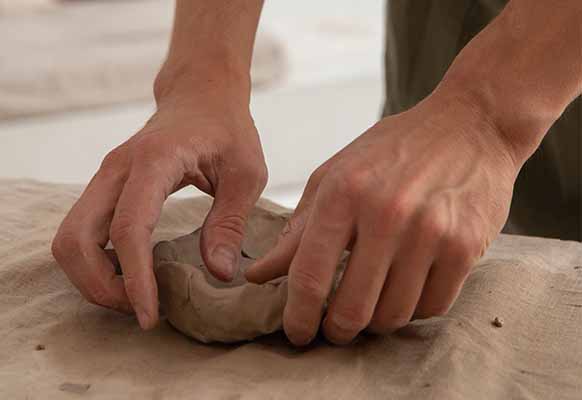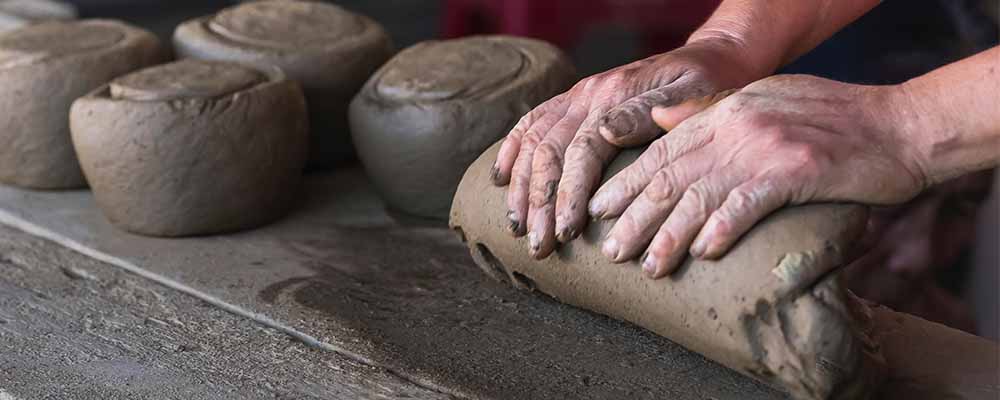If you’ve just begun to explore pottery as a hobby, I’m sure you’ve heard of the term grog. And perhaps it made you think of beer or any alcoholic drink.
So what is grog in clay?
Grog is a pre-fired material potters use as an additive for building, shaping, and firing clay. People use it for several reasons, which we will discuss in this article. We will also talk about the types of grog, their characteristics, and the effect they have on ceramics.
If you’re new to pottery, grog can help bring out the best in your works. So, if you are interested in learning more about grog in clay and how you can use it for pottery, keep reading.
What is a grog made of?
Grog contains high amounts of alumina and silica, as well as low percentages of iron oxide, calcium oxide, and magnesium. Alumina is a chemical compound which consists of aluminum and oxygen. Silica is an abundant mineral that occurs naturally and is usually present in quartz.

Grog takes its mechanical strength from alumina and its structural integrity from silica. Alumina compound in clay helps it tolerate high degrees of wear and tear while silica helps to regulate shrinkability.
What is a grog used for?
In pottery, the term temper pertains to a material one adds to the clay to make the resulting product more resilient. Grog in clay serves as a temper. When added to the clay, it has several benefits.
Improving pottery strength and resilience
Grog is a non-plastic material. When added to clay, it reduces its plasticity or its flexibility but adds structural strength, which helps the clay hold its shape better.
In a sense, it increases the clay’s workability. However, high grog content in clay bodies can feel rough on the hands due to the gritty texture and may sometimes cause skin irritation.
When heated, clay expands in the kiln. This process is known as thermal expansion. When pottery expands during firing, it becomes brittle, causing it to crack.
Grog helps decrease chances of cracking and prevents defects. Because it is a pre-fired material, it has already gone through the process of thermal expansion and is therefore not nearly as heat-sensitive as clay without grog. Grogged clay is usually fired quicker than normal clay because it promotes even heat distribution.
It also makes clay become porous, helping it to dry evenly. The porous surface allows water to escape and evaporate without obstruction.
Reducing clay shrinkage
When drying, all ceramics typically shrink by around 6%. Now, because grog improves drying in clay, it also reduces shrinkage. Because it has already been fired, and sometimes pulverized, it has much less water content, and thus the clay loses less volume as it dries.
Adding texture to pottery
Many potters also use grog to add texture to pottery. It gives ceramics a gritty or toothy look. However, if you add a proper amount of grog to the clay, it can benefit your pottery without affecting its smooth finish.
Grogged clay reacts to the chemicals present in glaze and affects the output after glazing. As a result, it adds a shiny texture to ceramics and other pottery pieces.
Other Uses
Apart from enhancing clay, grog is also used in sculptures, and other large-scale artworks. It is also a component for sealants used for high-temperature applications. Stone ovens for baking pizza, for instance, are made of chamotte, which is another name for grog. Grog is also present in fire-resistant bricks and mortar used to construct fireplaces and furnaces.
How do I use grog in pottery?
You can use grog however you want. You can mix it into clay bodies before shaping them in a potter’s wheel. You can also sprinkle them over a clay slab before letting it dry, as shown in this video:
How much grog should I use?
The amount of grog you need depends on whether you will be using it for structural support or simply for texture. You can try mixing about 5% of your clay body’s weight and add more until you get your desired clay strength or structure.
How do I make grog?
Grog is essentially a fired clay body that has been ground or pulverized and added to other clay bodies. Technically, you can make your own.
You can use old pots or pieces of ones you attempted to create but didn’t quite make it. You can crush them manually using a hammer.
However, it’ll be much easier if you have equipment such as a cement mixer. Watch this video on how to make grogs at home:
What are the types of grog in clay?
Grog in clay is categorized either into soft or hard, or according to mesh size.
Hard grog, as the name suggests, has been fired under high temperature or above cone 10, while soft grog has been heated below cone 10. Hard grog is robust and more commonly used in pottery. Soft grog is porous and much less sticky.
Grog can also be classified according to the size of its granules, or by the number of holes in one mesh. If a grog has 150 holes per inch in a piece of mesh, it is categorized as 150 mesh. A higher number indicates smaller grain size. The finer the grog, the more it decreases a clay’s plasticity.
Conclusion
Grog may look like plain crushed rocks, but it is a versatile material. It gives pottery a unique textured look and makes the processes of throwing and firing clay much easier for you. The resulting product is also stronger and more durable, thanks to the grog.
It only goes to show that something that may not be aesthetically pleasing on its own can produce something that is not only beautiful but also resilient.

